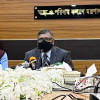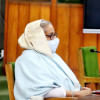Omicron raging at community level: DGHS

Community transmission of the quick-spreading Omicron variant of the coronavirus is now occurring in Bangladesh, said health officials yesterday -- in an acknowledgement that forebodes an unprecedented surge in cases in the days ahead.
The positivity rate is a useful measure of how much the coronavirus is spreading in a community. When the positivity rate of COVID-19 tests increases, it can mean that more virus is spreading in the community.
Since January 1, the positivity rate has increased more than 15 times.
And yesterday's positivity rate of 31.29 percent was the highest since July 30 last year, when the Delta variant swept through the country leaving hospitals at breaking point.
Bangladesh saw its highest positivity rate of 33 percent on July 24 last year.
"There has been community transmission of Omicron," said Nazmul Islam, spokesperson of the Directorate General of Health Services (DGHS), in a press bulletin yesterday.
First identified in Botswana and South Africa in November last year, the Omicron has a distinctive combination of more than 50 mutations, allowing it to dodge antibodies produced by vaccines and previous infections.
Global data shows it is two to three times as likely to spread as Delta, which explains the surge in new cases over the past few weeks.
In Bangladesh, which experienced months of low deaths and cases, cases started picking up again around the same time that Omicron was identified on December 9 last year.
In the 24 hours to 8 am yesterday, the DGHS reported 10,906 new cases, up from 9,614 in the preceding day.
The deadly Delta variant is still dominant, according to Islam.
"Omicron is gradually taking the place of Delta," he said, while presenting a statistic on the sign and symptoms of the Omicron infected patients during the bulletin.
The runny nose appears to be giveaways of infection with the Omicron variant: 73 percent experienced it.
It was followed by headache (68 percent), fatigue (64 percent), sneezing (60 percent), sore throat (60 percent) and cough (44 percent).
The DGHS compiled the data from different sources at home and abroad for mass awareness, Islam told The Daily Star yesterday.
"We have to keep these symptoms [of Omicron infection] in mind. They are, however, similar to those of seasonal flu and influenza," he said, adding that one should seek medical advice if one experience any of the symptoms.
Asked when to get to the hospital, he said: "When any Covid-19 positive patient experiences unpleasant physical conditions like lower oxygen saturation [breathing difficulties], abnormal increase in sugar level or hypertension or any, they should go to the hospital."
At the bulletin, Islam said the upward trend of Covid-19 cases will not stop if people continue to break the hygiene rules.
"The number of patients at hospitals has increased significantly, and this trend is continuing," he said.
He also put caution over the upcoming book fair.
"We would like to request that those who are associated with the book fair complete their vaccination before the start of the fair."
Anyone who attends the book fair, especially those over the age of 60 or who work on the frontlines, should get their booster dose of the Covid-19 vaccine.

 For all latest news, follow The Daily Star's Google News channel.
For all latest news, follow The Daily Star's Google News channel. 







Comments